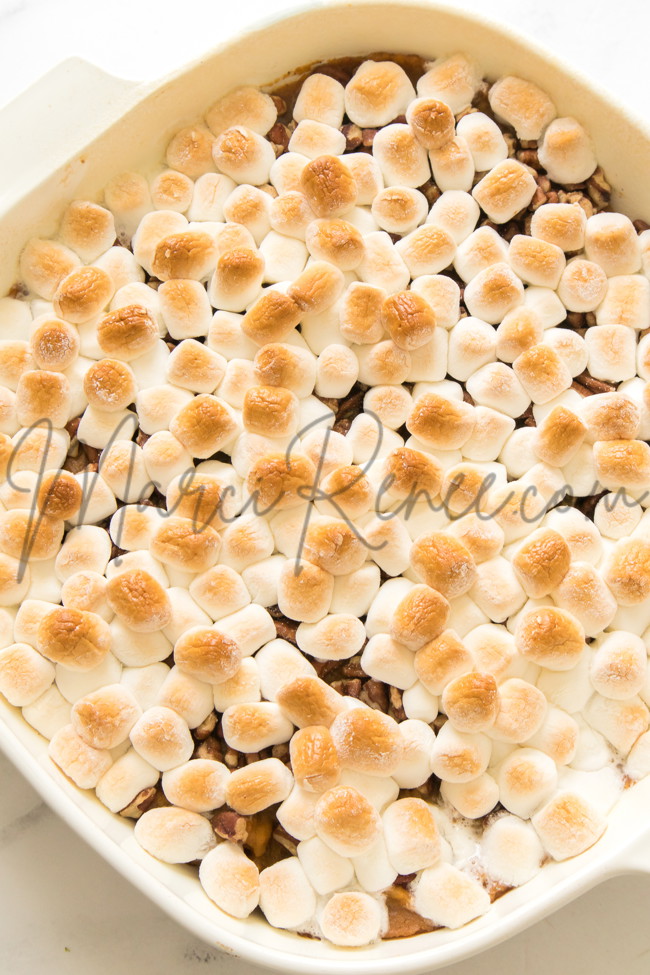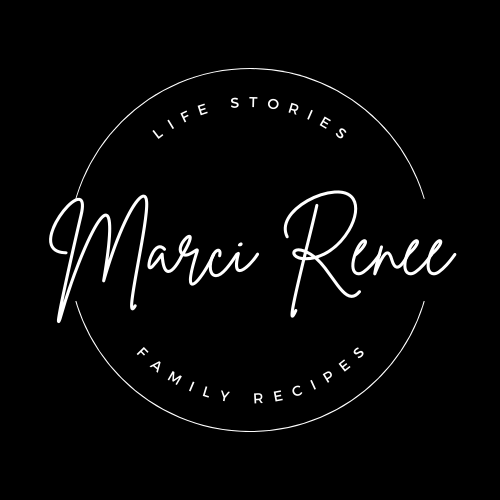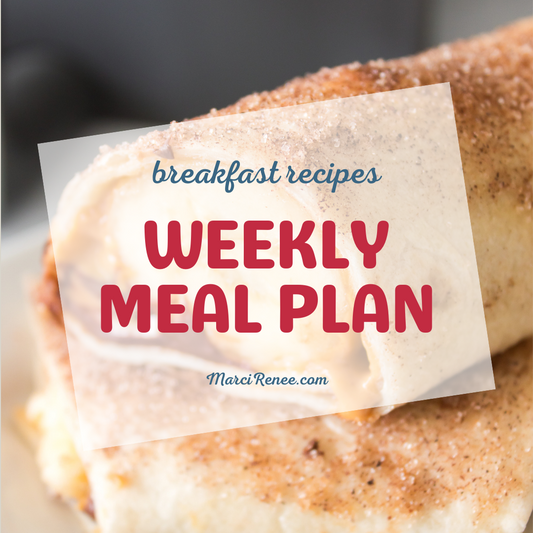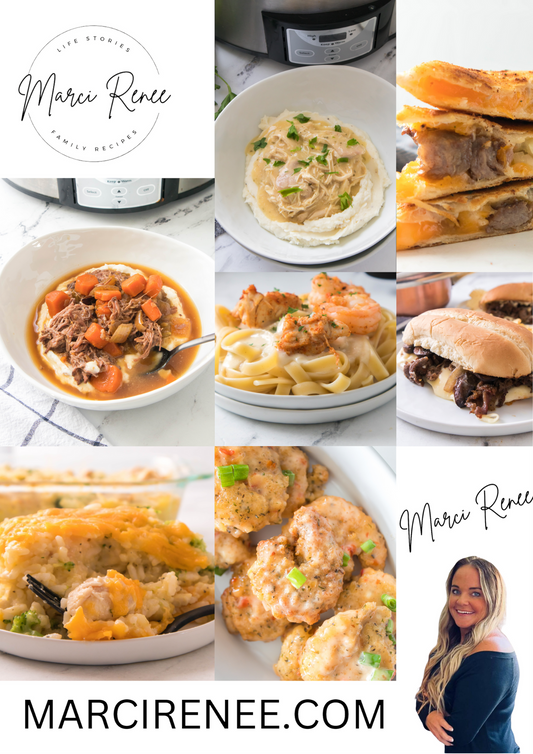Sweet Potato Casserole Recipe [Best Holiday Dish!] (+Video)
Marci LoehnerShare
Hi there! Ever stumbled upon a recipe that becomes an instant family favorite? That's exactly what happened when I bit into this sweet potato casserole recipe. Whether you're planning a grand holiday feast or simply want to enjoy a touch of comfort food, this dish fits right in.
I'm excited to share how this versatile and delicious casserole has transformed our holiday dinners. It's rich, creamy, and topped with a delightful ooey-gooey marshmallow topping that has everyone coming back for seconds. If you're looking to elevate your Thanksgiving or Christmas menu, this is the recipe you'll want to try!

Why You'll Love This Sweet Potato Casserole
This sweet potato casserole is a crowd favorite for a reason! It's more than just a side dish; it's a burst of comfort and flavor that leaves everyone asking for more!
- Delicious Flavor: Creamy sweet potatoes with a crunchy topping
- Easy to Prepare: Simple steps and common ingredients
- Crowd-Pleaser: Loved by everyone, from kids to adults
- Versatility: Can be adapted for various dietary needs
- Nostalgic Comfort: Bringing back holiday memories
- Nutritious: Full of vitamins and fiber
This sweet potato casserole is more than just a recipe; it's a tradition in the making.

Can I Eat Sweet Potato Casserole On a Keto or Low Carb Diet?
Sweet potato casserole is typically not considered compatible with a strict ketogenic diet due to its higher carbohydrate content. Sweet potatoes are naturally higher in carbs compared to other vegetables allowed in keto diets, such as leafy greens or cruciferous vegetables. The ketogenic diet emphasizes low-carb, moderate-protein, and high-fat foods to induce and maintain a state of ketosis, where the body burns fat for fuel instead of carbohydrates.
However, you can modify sweet potato casserole to make it more keto-friendly by using alternatives such as cauliflower or pumpkin, which are lower in carbs. These substitutions can help reduce the overall carb content while still providing a similar texture and flavor profile. Always check the specific ingredients and calculate the nutritional content to ensure it fits within your daily carb limits if you're following a ketogenic diet.

:recipekit:
Ingredients For Sweet Potato Casserole
- canned yams
- brown sugar - use Sukrin Gold if doing Keto or low carb.
- maple syrup - substitute with Sukrin Syrup Gold.
- unsalted butter
- salt
- ground cinnamon
- nutmeg
- vanilla extract
- chopped pecans
- mini marshmallows
For keto-friendly substitutes for chopped pecans and marshmallows in recipes, here are some options:
-
Chopped Pecans Substitutes:
- Chopped Walnuts: Walnuts have a similar texture and nutty flavor to pecans and are lower in carbs.
- Chopped Almonds: Almonds provide a crunchy texture and are a versatile option in both sweet and savory dishes.
- Chopped Macadamia Nuts: Macadamia nuts are rich and buttery, making them a delicious substitute for pecans.
-
Marshmallows Substitutes:
- Sugar-Free Marshmallows: Look for sugar-free marshmallows sweetened with alternatives like erythritol or stevia. These can be found in some specialty stores or online.
- Whipped Cream: A dollop of whipped cream can provide a creamy and slightly sweet alternative without adding significant carbs.
- Toasted Coconut Flakes: Toasted coconut flakes can mimic the texture of marshmallows and add a hint of sweetness to recipes.
When substituting ingredients on a ketogenic diet, always check the nutritional information to ensure they fit within your daily carb limit. These alternatives can help you enjoy keto-friendly versions of your favorite recipes while maintaining ketosis.
How to Make a Sweet Potato Casserole
Heat oven to 375 degrees F. Grease the inside of an 8x8-inch baking dish with non stick cooking spray.

Place yams into a large mixing bowl and mash.

Add brown sugar, syrup butter, salt, cinnamon, nutmeg and vanilla extract. Stirring to incorporate.

Spread mixture into an even layer in the prepared baking dish. Sprinkle with pecans and top with marshmallows.

Bake for 20 minutes or until marshmallows are toasted. Remove pan from oven and serve while warm.

Tips and Tricks for the Perfect Casserole
- Choosing the Right Sweet Potatoes: Opt for Orange Flesh and freshness. Also look for uniform size when picking your sweet potatoes for even cooking. This makes it easier for mashing.
- Cut Evenly: When chopping your sweet potatoes, try to cut them into evenly-sized pieces. This helps them cook uniformly, so you don’t end up with undercooked chunks.
- Don’t Overcook: Cook the sweet potatoes until they are just tender. Overcooking can make them watery, which may affect the texture of your casserole.
- Mash Thoroughly: Use a potato masher or even a hand mixer to ensure your sweet potatoes are smooth. Lumpy sweet potatoes can lead to an uneven texture in your casserole.
Avoiding Common Mistakes
- Don’t Skip the Binding: The eggs in your casserole play a crucial role in binding everything together. Skipping them can lead to a runny dish that falls apart.
- Proper Layering: Always layer your sweet potato mixture first, followed by the topping. Mixing them together can result in a less satisfying texture.
- Watch the Consistency: If your casserole mixture is too thin, it won’t hold its shape. If it’s too thick, it might be dense. Aim for a consistency that's thick enough to hold together but smooth enough to spread easily.
Variations to Try
Nut Variations
Nuts add a delightful crunch and flavor to your sweet potato casserole. While pecans are a classic choice, there are plenty of other nut options to explore. Each nut brings its own unique taste and texture, allowing you to customize your casserole to your liking.
- Walnuts: Walnuts have a slightly bitter taste that contrasts nicely with the sweetness of the casserole. They also provide a crunchy texture that elevates every bite.
- Almonds: Sliced or slivered almonds add a delicate crunch and a mild, nutty flavor. They can also give your casserole a more elegant appearance.
- Mixed Nuts: Why settle for one type of nut when you can mix them? A combination of almonds, walnuts, and even hazelnuts can bring a variety of textures and flavors, making every forkful a delightful surprise.
Savory Twists
Who says sweet potato casserole has to be only sweet? Adding savory elements can create a delightful contrast and make the dish even more flavorful. Here are some savory twists you might want to try:
- Cheese: Cheese lovers, rejoice! Adding cheese to your sweet potato casserole can create a creamy and savory layer. Cheddar cheese works great for this. Just sprinkle some shredded cheddar between the layers of sweet potato for a delightful gooey surprise.
- Bacon Bits: Everything is better with bacon, right? Sprinkle crispy bacon bits over the top of your casserole before baking. The smoky, salty flavor of bacon pairs remarkably well with the sweetness of the sweet potatoes.
- Herbs and Spices: Adding fresh herbs like rosemary or thyme can elevate the flavor profile of your casserole. You can also sprinkle some black pepper or paprika for an extra kick.
How to Store and Reheat
Properly storing your sweet potato casserole will keep it delicious for days. Before storing, allow the casserole to cool to room temperature. This helps prevent condensation, which can make the casserole soggy. Next, transfer the leftover casserole into an airtight container or cover the baking dish tightly with plastic wrap or aluminum foil. Place the container in the refrigerator. Stored this way, your casserole will stay fresh for up to 4 days.
If you want to keep it longer, you can freeze the casserole. Wrap it tightly in plastic wrap and then in aluminum foil to prevent freezer burn. It will keep well for up to 2 months.
Reheat the casserole in the oven or the microwave. You can also reheat the casserole on the stovetop.
FAQs
Can I make this casserole ahead of time?
Absolutely! Making your sweet potato casserole ahead of time is a great way to reduce holiday stress. Here’s how you can prepare it in advance:
- Prepare the Casserole: Follow the recipe up to the point of baking. This means peeling, boiling, and mashing the sweet potatoes, then mixing them with all the ingredients and adding your chosen topping.
- Cover and Store: Once your casserole is assembled (but not baked), cover it tightly with plastic wrap or aluminum foil. Store it in the refrigerator for up to 24 hours.
- Bake When Ready: When you’re ready to serve the casserole, remove it from the refrigerator and let it sit at room temperature for about 30 minutes. Preheat your oven to 350°F (175°C) and bake as directed, adding an extra 5-10 minutes to the baking time if necessary to ensure it’s hot and bubbly.
What can I use as a substitute for marshmallows?
Not a fan of marshmallows or looking for something different? There are plenty of delicious alternatives to top your sweet potato casserole:
- Brown Sugar Crumble: Combine 1/2 cup of flour, 1/2 cup of brown sugar, and 1/4 cup of melted butter. Sprinkle this mixture over the casserole for a sweet, crunchy topping that adds a delightful texture.
- Whipped Topping: For a lighter option, you can use whipped cream or whipped topping (like Cool Whip) to add a sweet finish. Just dollop it on top before serving.
- Coconut Flakes: Toasted coconut flakes can add a sweet and tropical twist, offering a different kind of sweetness and a bit of crunch.
Each of these options can provide the perfect finishing touch to your casserole, making it unique and tailored to your taste.
Is this recipe gluten-free?
The basic sweet potato casserole recipe is naturally gluten-free, but it’s important to check each ingredient to ensure it meets your dietary needs. Here’s how to make sure:
- Sweet Potatoes: Naturally gluten-free.
- Butter and Sugar: These are typically gluten-free, but always check the label for additives.
- Milk: Most milk is gluten-free, but double-check if using a milk substitute.
- Vanilla Extract: Choose a pure vanilla extract without added gluten.
- Eggs: Naturally gluten-free.
- Topping: This is where you need to be cautious. If you’re using a crumble topping, opt for gluten-free flour or oats.
Sweet Potato Casserole
Rated 5.0 stars by 1 users
Category
Side Dish
Cuisine
American
Author:
Marci
Servings
6
Prep Time
5 minutes
Cook Time
20 minutes
I'm excited to share how this versatile and delicious this Sweet Potato Casserole has transformed our holiday dinners. It's rich, creamy, and topped with a delightful ooey-gooey marshmallow topping that has everyone coming back for seconds. If you're looking to elevate your Thanksgiving or Christmas menu, this is the recipe you'll want to try!

Ingredients
- 29 oz. can canned yams, drained
- 1/4 cup brown sugar
- 2 Tablespoons maple syrup
- 3 Tablespoons unsalted butter, softened or melted
- 1 teaspoon salt
- 1 teaspoon ground cinnamon
- 1 teaspoon nutmeg
- 1/2 teaspoon vanilla extract
- 1/2 cup chopped pecans
- 1 ½ c mini marshmallows
Directions
Heat oven to 375°F. Grease the inside of an 8x8-inch baking dish with non stick cooking spray.
- Place yams into a large mixing bowl and mash.
- Add brown sugar, syrup butter, salt, cinnamon, nutmeg and vanilla extract. Stirring to incorporate.
- Spread mixture into an even layer in the prepared baking dish. Sprinkle with pecans and top with marshmallows.
- Bake for 20 minutes or until marshmallows are toasted. Remove pan from oven and serve while warm.
Recipe Video
Recipe Note
Did you enjoy this recipe? If so, please head over to MarciRenee.com and leave a review on the recipe post itself! Every review helps!





